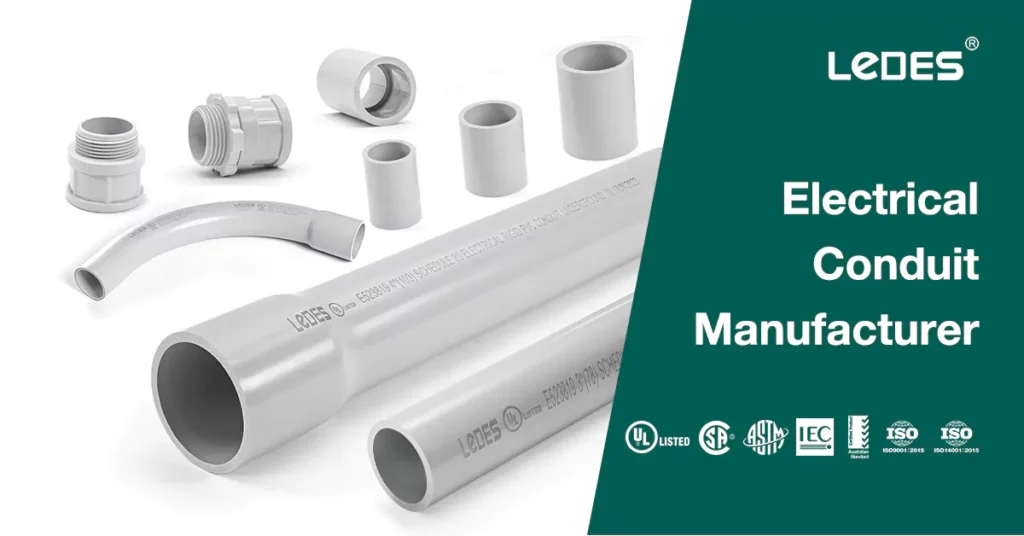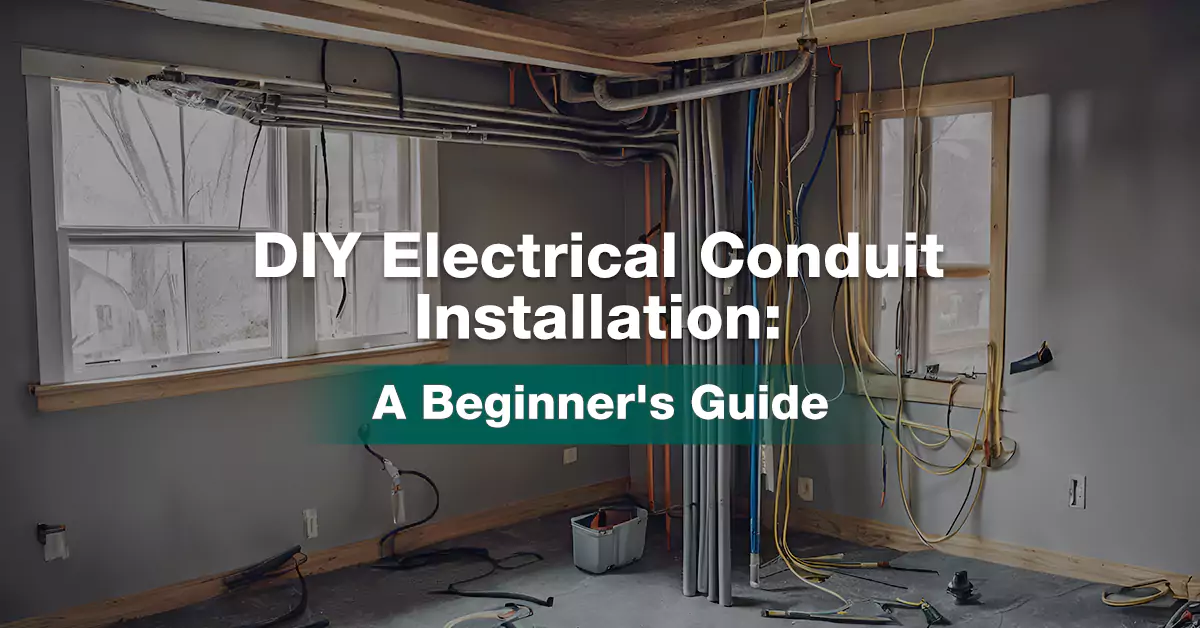
Tabla de contenido
Instalar conductos eléctricos por su cuenta puede ser una experiencia gratificante, ya que le permitirá personalizar su hogar y, potencialmente, ahorrar dinero. Instalar conductos proporciona una ruta segura y organizada para el cableado, lo que mejora tanto la estética como la seguridad. Esta guía lo guiará a través del proceso de instalación de conductos de PVC, lo que garantizará un resultado exitoso y, al mismo tiempo, priorizará la seguridad y el cumplimiento de las normas.
Un conducto eléctrico es una estructura en forma de tubo que se utiliza para encerrar y proteger cables y alambres eléctricos dentro de edificios, estructuras y diversas aplicaciones. Piense en él como un sistema de autopistas para la electricidad, que mantiene los cables organizados, seguros y protegidos de daños.
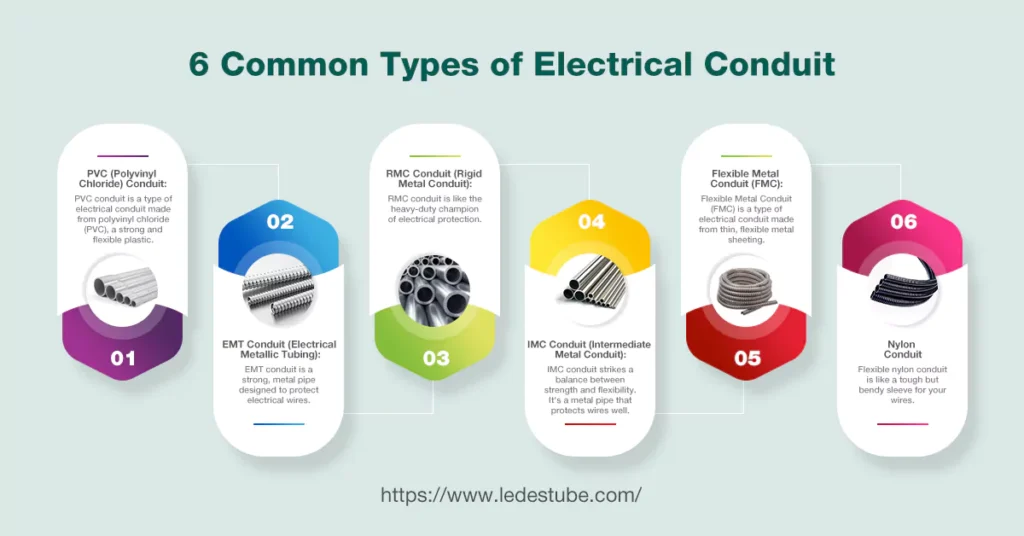
Aquí están 6 tipos comunes de conductos eléctricos, explorando sus ventajas, desventajas y aplicaciones típicas:
Conducto de PVC Es un tipo de conducto eléctrico fabricado con cloruro de polivinilo (PVC), un plástico resistente y flexible. Se utiliza para proteger el cableado eléctrico en el interior de edificios y estructuras. El PVC es ligero, resistente a la humedad y relativamente económico, lo que lo hace popular para aplicaciones residenciales y algunas comerciales.
Ventajas: Ligero, económico, fácil de trabajar, resistente a la humedad y a la corrosión.
Contras: No es tan fuerte como los conductos de metal, puede volverse quebradizo en temperaturas extremas, resistencia limitada al fuego.
Aplicaciones: Cableado residencial, instalaciones eléctricas de uso general, lugares interiores secos.
El conducto EMT es un tubo de metal resistente diseñado para proteger los cables eléctricos. ¡Piense en él como un escudo resistente que mantiene su cableado seguro y organizado!
Ventajas: Durable, relativamente económico, fácil de doblar e instalar, proporciona un buen nivel de conexión a tierra.
Contras: Puede ser más pesado que el PVC, susceptible a la corrosión en ambientes hostiles y no tan resistente al fuego como otros tipos.
Aplicaciones: Cableado residencial y comercial, aplicaciones industriales ligeras, áreas que requieren cierto grado de conexión a tierra.
El conducto RMC es como el campeón de la protección eléctrica de alta resistencia. Es un tubo de metal superresistente diseñado para mantener el cableado a salvo incluso en condiciones difíciles.
Ventajas: Extremadamente duradero, fuerte, altamente resistente al fuego y al impacto, proporciona excelente protección eléctrica y conexión a tierra.
Contras: Más caro que el PVC o el EMT, más pesado y más difícil de doblar, requiere herramientas especializadas para su instalación.
Aplicaciones: Aplicaciones industriales de servicio pesado, instalaciones al aire libre, áreas con alta vibración o riesgo de daño físico.
El conducto IMC logra un equilibrio entre resistencia y flexibilidad. Es un tubo de metal que protege bien los cables, pero es más liviano y más fácil de trabajar que su primo superresistente, el RMC.
Ventajas: Más resistente que EMT pero más ligero que RMC, buen equilibrio entre durabilidad y facilidad de instalación.
Contras: Más caro que el PVC o el EMT, no tan resistente al fuego como el RMC.
Aplicaciones: Edificios comerciales, aplicaciones industriales que requieren protección de servicio medio, instalaciones al aire libre en entornos menos hostiles.
El conducto metálico flexible (FMC) es un tipo de conducto eléctrico fabricado con láminas metálicas delgadas y flexibles. Permite un fácil enrutamiento alrededor de curvas y espacios reducidos, lo que lo hace ideal para aplicaciones donde no es necesaria la rigidez.
Ventajas: Altamente flexible, lo que permite enrutarlo fácilmente alrededor de obstáculos y en espacios reducidos.
Contras: Menos duradero que los tipos de conductos rígidos, no tan resistente para cargas pesadas o aplicaciones de alta vibración.
Aplicaciones: Cableado de electrodomésticos, instalaciones exteriores donde la flexibilidad es crucial, áreas con espacio limitado.
El conducto de nailon flexible es como una funda resistente pero flexible para los cables. Está hecho de nailon resistente y es ideal para mantener los cables organizados y seguros.
Ventajas: Altamente flexible, resistente a productos químicos y a la humedad, liviano, ideal para agrupar múltiples cables.
Contras: No tan fuerte como los conductos metálicos, menor resistencia al fuego en comparación con algunos metales.
Aplicaciones: Cableado automotriz, aplicaciones marinas, paneles de control, instalaciones al aire libre en entornos no peligrosos.
Recordar: Al elegir el conducto adecuado, tenga en cuenta factores como el entorno, la capacidad de carga, los niveles de protección requeridos y los códigos de construcción locales.
Elegir el conducto adecuado para su proyecto es fundamental para la seguridad, el rendimiento y la durabilidad. A continuación, se detallan los factores que se deben tener en cuenta:
Cableado residencial: El PVC es a menudo la opción preferida debido a su asequibilidad, facilidad de instalación y buena protección general para las necesidades típicas de cableado doméstico.
Edificios comerciales: Dependiendo de los requisitos de carga y las normas locales, se puede preferir el uso de EMT o IMC. El RMC se utiliza en áreas con mayor vibración o estrés físico.
Aplicaciones industriales: El RMC y el IMC son excelentes en entornos exigentes debido a su resistencia y durabilidad. El FMC puede ser útil para el cableado de maquinaria donde se necesita flexibilidad.
Instalaciones exteriores: Tenga en cuenta la resistencia a la humedad, la protección contra los rayos ultravioleta (PVC, algunos metales) y el posible impacto de los elementos climáticos. A menudo se eligen EMT, IMC o aleaciones de metales específicas.
Exposición a la humedad: El PVC y el nailon ofrecen una buena resistencia a la humedad, mientras que los metales pueden corroerse en ambientes húmedos. Elija acero galvanizado o acero inoxidable para entornos exteriores o húmedos.
Variaciones de temperatura: Las temperaturas extremas pueden afectar la flexibilidad y la resistencia de los conductos. Opte por materiales con un amplio rango de temperaturas de funcionamiento si es necesario.
Seguridad ante todo: El RMC y algunas aleaciones de metal ofrecen una resistencia al fuego superior en comparación con el PVC o el nailon. Considere esto como algo fundamental en áreas con alto riesgo de incendio.
Códigos de construcción: Muchas regiones exigen clasificaciones de resistencia al fuego específicas para los conductos en función del uso previsto. Consulte los códigos locales antes de tomar una decisión, como el NEC o relacionados.
Cargas pesadas: RMC e IMC son más adecuados para cableado de mayor amperaje, ya que pueden soportar el mayor calor generado.
Cargas ligeras: El PVC o EMT suelen ser suficientes para aplicaciones residenciales estándar o de bajo consumo.
Facilidad de doblado: El conducto metálico flexible (FMC) está diseñado para un fácil enrutamiento, mientras que los conductos rígidos como el RMC requieren herramientas especializadas y experiencia para doblarlos.
Accesibilidad: Considere las necesidades futuras de mantenimiento. El PVC y algunos metales son más fáciles de acceder y modificar que los conductos herméticamente sellados o muy incrustados.
CLORURO DE POLIVINILO: Generalmente la opción más asequible.
Técnico en emergencias médicas: De coste medio.
CMI: Más caro que EMT pero menos costoso que RMC.
C.R.M.: Generalmente es el más caro debido a su resistencia y durabilidad.
Consulte siempre los códigos de construcción locales para conocer los requisitos específicos sobre el tipo de conducto, el tamaño y los métodos de instalación.
Al considerar cuidadosamente estos factores, puede seleccionar el mejor conducto eléctrico para su proyecto, garantizando seguridad, rendimiento y confiabilidad a largo plazo.
Le sugerimos que vuelva a consultar con su electricista local o mayorista electrico Si no entiendes esto.
Más allá de su apariencia ordenada, los conductos eléctricos ofrecen varios beneficios:
Protege los cables contra daños físicos, humedad y posibles peligros de conexión a tierra.
Organización y accesibilidad: mantiene el cableado ordenado y etiquetado para facilitar la resolución de problemas y el mantenimiento futuro.
Muchos materiales de conductos ofrecen propiedades resistentes al fuego, lo que mejora la seguridad general del hogar.
Proporciona una solución duradera que resiste el desgaste, preservando la integridad de su sistema eléctrico.
Opte por conductos de PVC reciclados o reciclables para minimizar el impacto ambiental.
Explore conductos inteligentes con sensores integrados para preparar su configuración eléctrica para el futuro.
Antes de iniciar cualquier trabajo eléctrico, priorice siempre la seguridad:
Apagar la energía: Desconecte la fuente de alimentación del circuito en el que está trabajando en la caja de interruptores. Utilice un comprobador de voltaje sin contacto para comprobar si hay cables con corriente.
Utilice equipo de protección: Los guantes, las gafas de seguridad y las mangas largas protegen contra descargas eléctricas y posibles residuos.
Utilice las herramientas adecuadas: Invierta en herramientas de calidad como pelacables, dobladores de conductos y un cuchillo multiuso para realizar un trabajo preciso y seguro.
Trabajar con un socio: Contar con la ayuda de alguien puede mejorar la seguridad y proporcionar un segundo par de ojos.
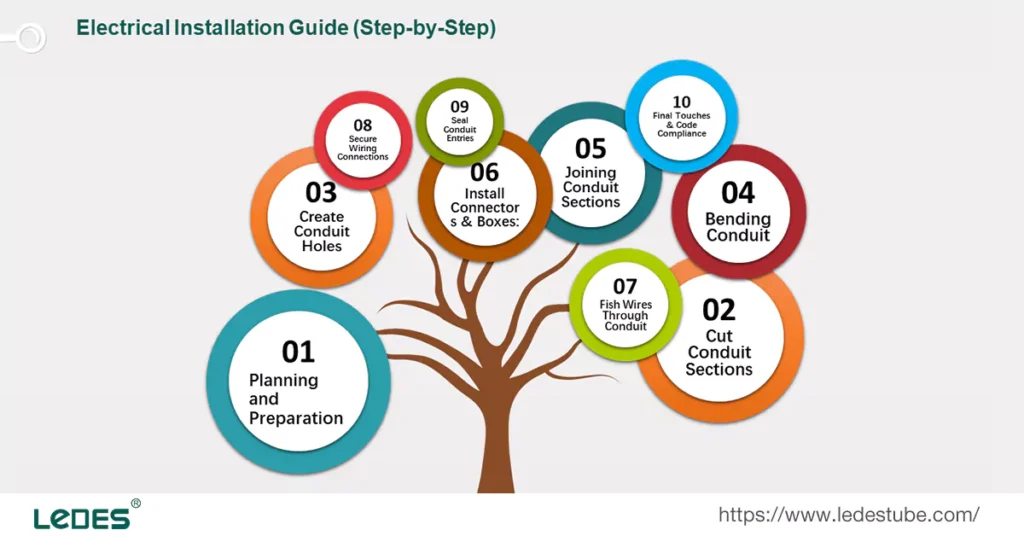
Determine el recorrido del conducto, mida las longitudes con precisión y marque el camino deseado en las paredes o los techos.
Utilice un cortador de conductos para realizar cortes limpios y rectos. Evite los bordes irregulares que pueden dañar los cables.
Perfore agujeros guía donde sea necesario, asegurándose de que sean ligeramente más grandes que el diámetro del conducto para una inserción suave.
Para las curvas, utilice un doblador de conductos de acuerdo con las instrucciones del fabricante. Marque el ángulo de curvatura y asegúrese de que el radio sea uniforme.
Utilice accesorios de conductos roscados (codos, conectores) y sellador o compuesto para roscas adecuado para realizar conexiones seguras.
Asegure las cajas de conexiones y las cajas de salida/interruptores dentro de sus conductos utilizando el hardware de montaje adecuado.
Pase los cables con cuidado por el conducto utilizando una cinta pasacables o una herramienta similar. Asegúrese de que haya suficiente holgura para evitar tensiones en las conexiones.
Realice terminaciones de cables seguras dentro de las cajas de conexiones, respetando los códigos de colores de cableado y los estándares del código eléctrico (NEC).
Utilice sellador o ojales adecuados alrededor de las entradas de los conductos en los recintos para evitar la entrada de humedad.
Ocultar conducto Conductos: Cubra los conductos expuestos con canalizaciones, yeso o pintura para lograr un aspecto limpio y terminado.
Etiquetado: Etiquete claramente las cajas de conexiones y los recorridos de cables para una fácil identificación durante trabajos futuros.
Consulte siempre los códigos eléctricos locales y busque asistencia profesional si encuentra instalaciones complejas o incertidumbres.

Asegurarse de que las instalaciones de conductos eléctricos cumplan con los códigos locales es fundamental para la seguridad, la funcionalidad y para evitar posibles multas o problemas en el futuro. A continuación, se incluye un desglose de los recursos clave de los códigos y las estrategias de cumplimiento tanto para Estados Unidos como para Canadá.
Código Eléctrico Nacional (NEC): El NEC, publicado por la Asociación Nacional de Protección contra Incendios (NFPA), es el principal código eléctrico estándar adoptado por la mayoría de los estados de los EE. UU. Si bien los estados pueden tener sus propias enmiendas, el NEC proporciona una Marco integral para prácticas de cableado seguro.
Selección de materiales: Se diseñan tipos de conductos específicos para diversas aplicaciones en función de factores como el entorno (lugares húmedos), la resistencia al fuego y la capacidad de carga.
Tamaño y capacidad: El NEC dicta los tamaños mínimos de los conductos en función de la cantidad de cables que pasan por su interior, su amperaje nominal y otros factores. La sobrepoblación puede provocar sobrecalentamiento y otros peligros.
Radio de curvatura y espaciado: Los radios de curvatura mínimos se establecen para evitar daños en los cables y garantizar un movimiento adecuado del cable dentro del conducto.
Técnicas de instalación: Los métodos de fijación seguros, los requisitos de conexión a tierra y las configuraciones de las cajas de conexiones están estandarizados.
Códigos eléctricos estatales:Comuníquese con la junta de licencias de su estado o con el Departamento de Trabajo para conocer los códigos específicos adoptados en su región.
Departamentos de construcción locales: El departamento de construcción de su ciudad o condado tendrá los requisitos del código local más actualizados, que a menudo incorporan el NEC y cualquier enmienda adicional.
Consulte a expertos locales: Comuníquese con electricistas autorizados que estén familiarizados con los códigos de su área para obtener orientación sobre instalaciones específicas.
Consulte los libros de códigos: Adquiera copias del NEC y los códigos locales pertinentes para familiarizarse con los requisitos detallados.
Recursos en línea: La NFPA ofrece recursos en línea e interpretaciones de códigos, mientras que varios sitios web proporcionan bases de datos de códigos que se pueden buscar.
Publicada por CSA Group, la CEC es la norma eléctrica nacional de Canadá, con un alcance similar al del NEC. Las jurisdicciones provinciales o territoriales pueden realizar modificaciones o adiciones a la CEC.
Requisitos clave relacionados con los conductos (similares al NEC de EE. UU.):
* Selección de material según la aplicación.
* Normas de tamaño y capacidad
* Pautas de flexión y espaciado
* Técnicas de instalación y requisitos de puesta a tierra
Códigos eléctricos provinciales: Cada provincia y territorio tiene su propia oficina de códigos eléctricos o su organismo regulador. Comuníquese directamente con ellos para conocer los requisitos específicos de los códigos de su jurisdicción.
Sitio web del Grupo CSA: El Grupo CSA proporciona acceso al CEC, enmiendas, boletines técnicos, y otros recursos en su sitio web.
Licencia de electricista: Contrate a electricistas autorizados familiarizados con los códigos canadienses para una instalación profesional.
Manténgase actualizado: Los códigos eléctricos se revisan y actualizan periódicamente. Manténgase informado sobre las revisiones y modificaciones suscribiéndose a las publicaciones de códigos o visitando los sitios web pertinentes.
Investigando diligentemente, Al comprender y cumplir con los códigos eléctricos nacionales y locales, puede garantizar que sus instalaciones de conductos sean seguras, cumplan con las normas y alcancen los más altos estándares de la industria.

Doblar correctamente los conductos eléctricos es fundamental para crear instalaciones limpias y ordenadas, a la vez que se garantiza que los cables permanezcan protegidos y accesibles. Esta guía le mostrará las técnicas y herramientas esenciales para lograr curvaturas de aspecto profesional en todo momento.
Herramienta para doblar: ¡La piedra angular del proceso! Elija una dobladora adecuada para el material de conducto elegido (EMT, RMC o IMC) y su tamaño. Los tipos más comunes incluyen dobladoras manuales, dobladoras hidráulicas y dobladoras eléctricas. En cuanto al conducto de PVC, generalmente solo necesita doblar un resorte.
Cinta métrica: Las mediciones precisas son cruciales para lograr curvas consistentes.
Marcador/Lápiz: Marque claramente las posiciones de curvatura deseadas.
Gafas de seguridad: Proteja sus ojos de los escombros que salen volando al doblar.
Revisión del plan: Estudie su plan de cableado e identifique todas las curvas necesarias, anotando sus ángulos y posiciones.
Medir dos veces, doblar una vez: Verifique dos veces las medidas antes de realizar cualquier corte o doblez.
Visualizar el diseño: Antes de comenzar a realizar curvas, diseñe un recorrido de práctica con un conducto similar para asegurarse de que las curvas planificadas fluyan sin problemas.
Corte recto y limpio: Asegúrese de realizar cortes limpios y rectos utilizando un cortador de conductos para lograr un doblado preciso. Elimine las rebabas o los bordes afilados con una lima.
Marque sus puntos de curvatura: Utilice un marcador o lápiz para indicar claramente el ángulo de curvatura y la ubicación en el conducto.
Dobladoras manuales:
- Alinee el conducto en la matriz dobladora, asegurándose de que quede bien asentado.
- Aplique una presión constante, doblando suavemente todo el arco del ángulo deseado. Evite sacudir o forzar el conducto.
- Libere la presión gradualmente para evitar torceduras o curvas desiguales.
Dobladoras hidráulicas:
- Coloque el conducto en la matriz de la dobladora y fíjelo con abrazaderas.
- Bombee la palanca hidráulica lenta y constantemente, controlando la fuerza de flexión.
- Suelte la palanca con cuidado una vez alcanzado el ángulo deseado.
Guías de ángulos: Muchas dobladoras incluyen guías de ángulo incorporadas para lograr curvas precisas. Utilícelas para obtener resultados uniformes.
La práctica hace al maestro: Experimente con diferentes técnicas de doblado y practique con conductos de desecho hasta lograr ángulos consistentemente precisos.
Comprobación visual: Inspeccione cada curva con cuidado para detectar torceduras, bordes afilados o cualquier desviación del ángulo deseado.
Medir de nuevo: Utilice un transportador o una regla para verificar que las curvas cumplan con las especificaciones planificadas.
Desbarbado: Retire las rebabas o los bordes afilados restantes con una lima para evitar lesiones y garantizar transiciones suaves de los conductos.
Si domina estas técnicas de doblado de conductos, podrá llevar sus instalaciones eléctricas de un cableado básico a una artesanía de nivel profesional. Recuerde: la práctica, la atención a los detalles y las herramientas adecuadas son la clave del éxito.
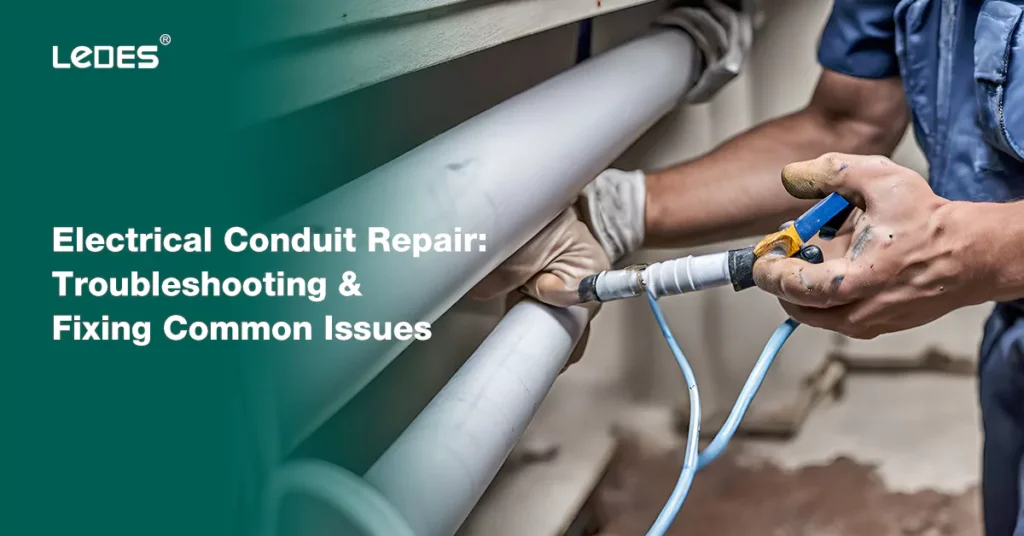
Lidiar con conductos dañados o que funcionan mal puede parecer abrumador, pero con los conocimientos y las herramientas adecuados, puede abordar estos problemas de manera segura y eficaz. Esta guía paso a paso le ayudará a identificar problemas comunes y le brindará soluciones para una reparación exitosa.
Apagar la energía: Antes de trabajar en cualquier sistema eléctrico, desconecte siempre la alimentación del circuito afectado en la caja de interruptores. Vuelva a verificar con un comprobador de voltaje sin contacto para asegurarse de que los cables estén desenergizados.
Equipo de protección: Use gafas de seguridad y guantes aislantes para protegerse de descargas eléctricas y posibles residuos.
Grietas y pinchazos: Busque grietas, agujeros o perforaciones visibles en el conducto que puedan dejar expuesto el cableado. Estos elementos comprometen la protección y pueden provocar cortocircuitos o daños.
Conexiones sueltas: Revise las cajas de conexiones y las conexiones dentro del conducto para ver si hay cables, tornillos o accesorios sueltos. Esto puede provocar caídas de voltaje y posibles peligros de chispas.
Corrosión y óxido: Inspeccione los conductos metálicos para detectar óxido o corrosión, especialmente en ambientes húmedos. Esto debilita la estructura y puede requerir el reemplazo de secciones.
Grietas y perforaciones (conductos de PVC):
Hay 3 pasos para arreglar las grietas en los conductos de PVC,
- Limpie minuciosamente el área dañada con un cepillo de alambre o papel de lija.
- Aplique un cemento adhesivo de PVC en ambas superficies de la grieta, asegurando un buen contacto.
- Presione las piezas firmemente y fíjelas durante el tiempo de curado especificado por el fabricante del cemento.
Grietas y perforaciones (conductos metálicos):
Los 3 sencillos pasos para arreglar las grietas de los conductos metálicos,
- Para grietas menores: utilice cinta de reparación de conductos de metal o un sellador compatible con el tipo de metal. Aplique según las instrucciones del producto.
- Para perforaciones más grandes o secciones dañadas: corte la sección afectada y reemplácela con un nuevo trozo de conducto.
- Asegure el conducto nuevo utilizando acoplamientos, conectores roscados o métodos de unión aprobados para su material de conducto específico.
Conexiones sueltas:
Apriete firmemente todos los tornillos y tuercas con un destornillador o una llave.
Si hay cables sueltos en los bloques de terminales dentro de la caja de conexiones, utilice pelacables para quitar el aislamiento y ajustar las conexiones utilizando terminales o conectores adecuados.
En caso de cableado dañado: reemplace con cuidado las secciones desgastadas o quemadas por un cable nuevo del mismo calibre. Asegúrese de que el aislamiento sea adecuado y de que las conexiones sean seguras.
Corrosión y óxido:
Elimine el óxido suelto o la corrosión con un cepillo de alambre, papel de lija o un removedor de óxido especializado.
Aplique una capa protectora como pintura antioxidante o imprimación para evitar una mayor corrosión.
En casos graves, puede ser necesario reemplazar el conducto.
Conexiones de prueba: Después de las reparaciones, vuelva a verificar que todas las conexiones estén ajustadas y funcionen correctamente utilizando un multímetro si es necesario.
Comprobación visual: Inspeccione nuevamente su trabajo para detectar posibles cables sueltos o áreas dañadas.
Restaurar energía: Vuelva a conectar con cuidado la energía en la caja de interruptores y pruebe la funcionalidad de los circuitos.
Recordar: Si se enfrenta a reparaciones complejas, no está seguro de los procedimientos de seguridad o no tiene experiencia trabajando con sistemas eléctricos, consulte a un electricista calificado para garantizar un resultado seguro y exitoso.
La instalación de conductos eléctricos por cuenta propia es posible con una planificación cuidadosa, el cumplimiento de las prácticas de seguridad y estas instrucciones paso a paso. Si prioriza la seguridad y el cumplimiento de los códigos, podrá actualizar el sistema de cableado de su hogar y, al mismo tiempo, mejorar tanto la funcionalidad como la estética.
Si aún tiene alguna pregunta, puede enviarnos un correo electrónico; nuestro experto trabajará con usted en 1 día hábil.



